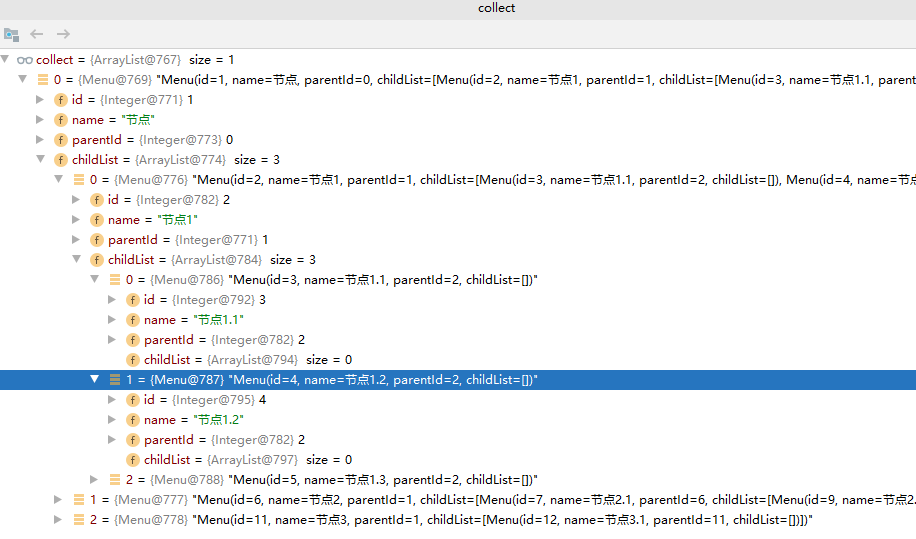使用Stream流递归 组合树形结构
有一些需求,比如构建菜单,构建树形结构,数据库一般就使用父id来表示,为了降低数据库的查询压力,我们可以一次性把数据查出来,然后使用Java8中的Stream流通过流式处理
实体类:Menu.java
import lombok.Builder; import lombok.Data; import java.util.List; @Data @Builder public class Menu { /** * id */ public Integer id; /** * 名称 */ public String name; /** * 父id ,根节点为0 */ public Integer parentId; /** * 子节点信息 */ public List<Menu> childList; public Menu(Integer id, String name, Integer parentId) { this.id = id; this.name = name; this.parentId = parentId; } public Menu(Integer id, String name, Integer parentId, List<Menu> childList) { this.id = id; this.name = name; this.parentId = parentId; this.childList = childList; } }
递归组装树形结构:
import java.util.Arrays; import java.util.List; import java.util.Objects; import java.util.stream.Collectors; public class Test { public static void main(String[] args) { testtree(); } public static void testtree() { //模拟从数据库查询出来 List<Menu> menus = Arrays.asList( new Menu(1, "节点", 0), new Menu(2, "节点1", 1), new Menu(3, "节点1.1", 2), new Menu(4, "节点1.2", 2), new Menu(5, "节点1.3", 2), new Menu(6, "节点2", 1), new Menu(7, "节点2.1", 6), new Menu(8, "节点2.2", 6), new Menu(9, "节点2.2.1", 7), new Menu(10, "节点2.2.2", 7), new Menu(11, "节点3", 1), new Menu(12, "节点3.1", 11) ); //获取父节点 List<Menu> collect = menus.stream() .filter(m -> m.getParentId() == 0) .peek(m -> m.setChildList(getChildrens(m, menus))) .collect(Collectors.toList()); System.out.println(collect.toString()); } /** * 递归查询节点 * * @param root 节点 * @param all 所有节点 * @return 节点信息 */ private static List<Menu> getChildrens(Menu root, List<Menu> all) { return all.stream() .filter(m -> Objects.equals(m.getParentId(), root.getId())) .peek(m -> m.setChildList(getChildrens(m, all))) .collect(Collectors.toList()); } }
结果:

文章参考:https://blog.csdn.net/qq_19244927/article/details/106481777


 浙公网安备 33010602011771号
浙公网安备 33010602011771号